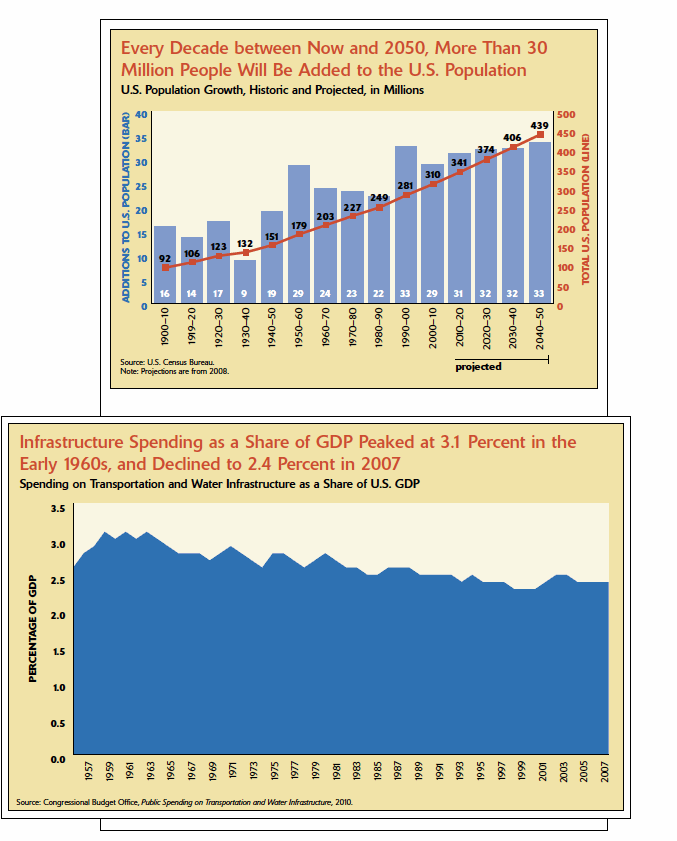URBAN LAND INSTITUTE
National Outlook
In 2011, “the U.S. effectively shrugs off infrastructure” in the face of escalating government deficits and cash-strapped taxpayers. Despite a welcome wave of political rhetoric about its importance to the country’s economic future and related worries about falling behind global challengers, a proactive U.S. infrastructure agenda remains buried underneath a long list of other budget imperatives—health care, Social Security, defense, public safety, and education, as well as the need to service the swelling government debt. No matter how desirable, ongoing investment in systems to keep the country competitive and functioning easily can get cast aside in the rush to plug budget leaks.
Instead of finding more dollars to meet growing needs to serve a steadily rising population—census forecasts estimate there will be almost 100 million more people in the country by 2040—politicians likely will budget less (or not enough) and take their chances in the years ahead. This approach probably suits average Americans just fine. Their more pressing concerns revolve around holding on to or finding good paying jobs, making mortgage payments to stay in their homes, or keeping up with rising medical insurance deductibles. As for infrastructure, it is easy to brush back numerous “the sky is falling” experts—“maybe the picture isn’t so bleak” since all those forecast disasters have not happened—and settle on a simple bottom line: “We have no interest in paying more.”
So now what?
“All signs point to a period when we won’t invest sufficiently in infrastructure on any level—federal, state, and local,” says an interviewee. “There is no impetus and no money.” The idea of energizing the economy and creating jobs around rebuilding America finds little support despite some presidential jawboning. Instead, Americans believe it is better to avoid boondoggles, keep taxes low, and reduce deficits. And little momentum exists for creating a national infrastructure agenda and policy to inform how limited funds can be invested more efficiently and productively, or can help wean the country off foreign oil.
The consensus view of interviewees for this report is that the United States likely will wallow in this what-me-worry hiatus “until disaster strikes or our decline becomes too obvious to ignore.” So far, Hurricane Katrina and the New Orleans levee breach have not been a big enough wakeup call; neither was the 2007 Minneapolis bridge collapse. Perhaps higher gasoline and energy prices resulting from Middle East turmoil will do the trick and galvanize more support for mass transit systems and rail lines. Only time will tell what gets the country’s collective attention to force action. “It’s amazing how hard everyone is making it in the U.S.,” a Brit observes. And meanwhile, “the condition gets worse and worse.”
In the meantime, it’s the same old story: Congress perennially refuses to hike gasoline taxes even in the face of growing transportation capital and maintenance needs. The federal gas tax has languished at 18.4 cents per gallon since 1993 while improving fuel efficiency standards promise to deplete its revenue-raising power further and weaken the already-drained federal Highway Trust Fund, which provides funding to states for roads and mass transit.
Download full version (PDF): Infrastructure 2011
About Urban Land Institute
www.uli.org
“The mission of the Urban Land Institute (ULI) is to provide leadership in the responsible use of land and in creating and sustaining thriving communities worldwide. Founded in 1936, the institute now has more than 40,000 members worldwide representing the entire spectrum of land use and real estate development disciplines, working in private enterprise and public service.”
Tags: ULI, Urban land Institute







 RSS Feed
RSS Feed